Tacoma Narrows Bridge history - Tale of three Bridge - 1950
A tale of three Bridge - 1950
"Sturdy Gertie" - This First Narrows Bridge
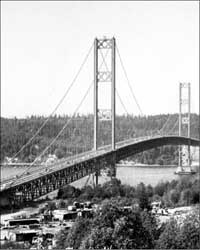
The second Narrows Bridge, labeled "Sturdy Gertie" by the newspapers and local promoters, opened to great fanfare. A large crowd, plus dignitaries and other politicians, attended the gala event.
At one mile in length, the existing 1950 bridge is the fifth longest bridge in the United States and represents the best of suspension bridge design, stability and engineering.
Following Gertie's demise, World War II delayed construction of Tacoma Narrows Bridge II for a full eight years. Shortages of steel and wire made such materials valuable commodities. Washington sold bridge steel as surplus, and the remains of the 1940 bridge cables and span were scraped.
The state financed the second bridge through a $14,000,000 bond issue. When the bridge opened in 1950, tolls were almost the same as for Gertie. The bridge remained a toll facility until the bonds were retired in May 1965, 13 years ahead of schedule.
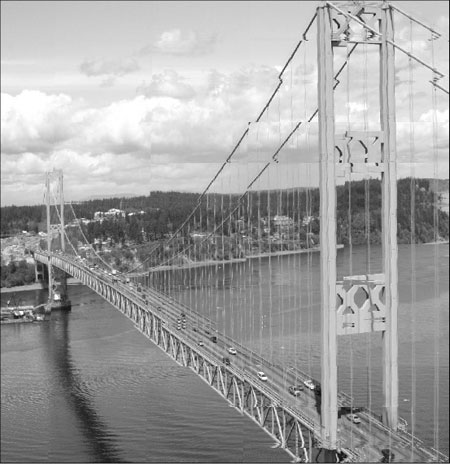
They called it "Sturdy Gertie." Nearly a decade passed between first Narrows Bridge's collapse in November 1940 and completion in October 1950 of the current bridge. The ten-year gap largely was the result of the redirection of money, materials, and manpower to fight World War II. In addition, insurance litigation slowed efforts to build a replacement bridge. Promoters gave the new bridge a nickname. Indeed the 1950 bridge proved sturdier than its predecessor. It was wider, heavier and stronger, and carried four lanes of traffic instead of two.
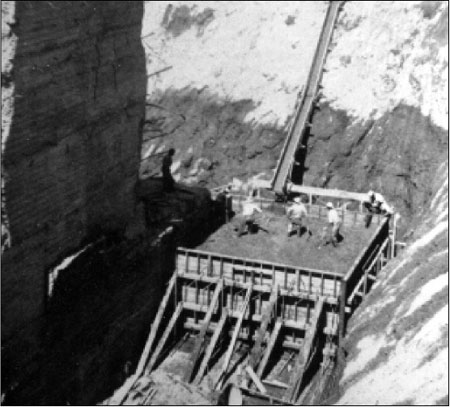
Heavier cables mean bigger anchorages. The new bridge had a much bigger cable load, increased from the original 28 million pounds to 36 million pounds. As a result the anchorages of the 1940 bridge needed to be modified. The old anchorages, spaced 39 feet apart, were retrofitted for the new span's 60-foot spacing between cables. The original structures became the cores of the new, heavier and wider 54,000-ton anchor blocks.
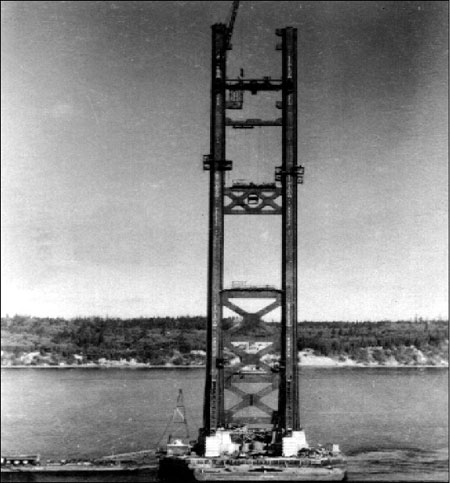
Raising up the new towers. Crews used a "crawler crane" to build the towers. It advanced upward as workers completed each tower leg. The legs of the 1950 towers are made of hollow steel cells, stacked on top of one another. The cell sections are four columns arranged to form a hollow core in the center. Each section is 32 feet long and weighs 27 tons. To stabilize the towers during construction, temporary "outriggers" were added until the cables and deck trusses could be completed.
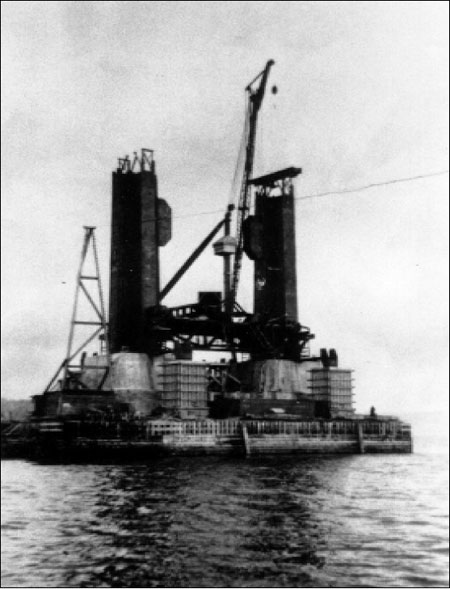
New bridge built on 1940 piers. Engineers faced two major challenges in building the second (current) bridge. First, they had to explain the failure of the 1940 bridge, and then design a new one to withstand the same fate. Next, they had to determine if remnants of the old bridge - the piers - could be used. The two main piers were undamaged and were used to support the second bridge with only minor modifications to the concrete pedestals.
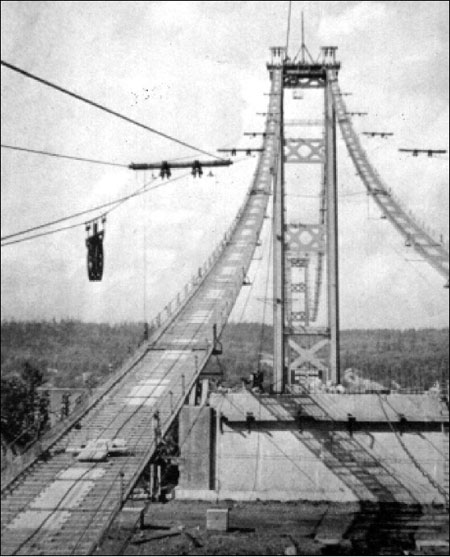
Cables & Spinning. Once the towers and cable saddles were in place, spinning began for the 20¼ inch diameter suspension cables. Spaced 60 feet apart, each cable contained 19 strands of 458 No.6 gauge wires.
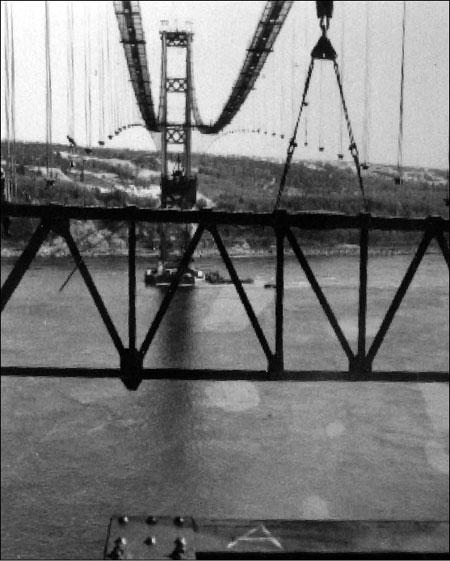
Raising a deck. The deck for the second bridge was built quite differently than the deck of the first. Crews raised steel beams singly or in sections. Assembling the deck, piece by piece, was like assembling a giant tinker toy.
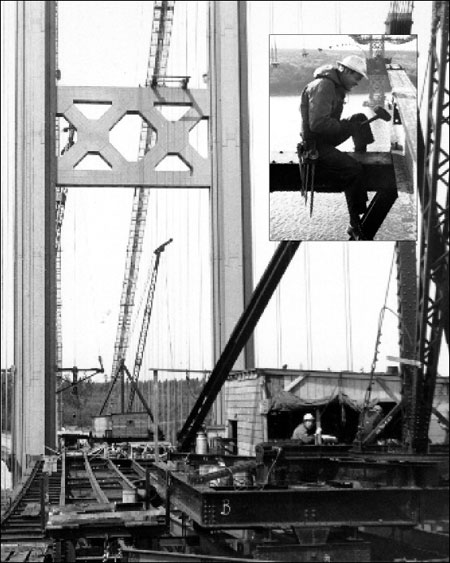
Bracing against the elements. The 33-foot deep Warren stiffening truss system was assembled at the bridge site from shop-fabricated components. Four rolling derricks (2 per tower) moved each way from the tower. Two riveting crews and traveler operators worked from the tower piers to the center of the main span, while two other crews worked from the piers o the shore.
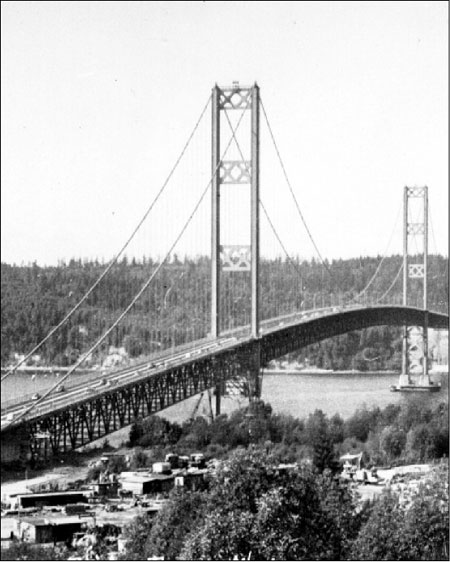
A second round of celebrations. On October 14, 1950, opening day celebrations capped the long process to build Galloping Gertie's replacement. The price tag for construction was one-third more than the Toll Bridge Authority estimated--$11.2 million. The final construction cost estimate, made just prior to the bond issue, reached $13,738,000.